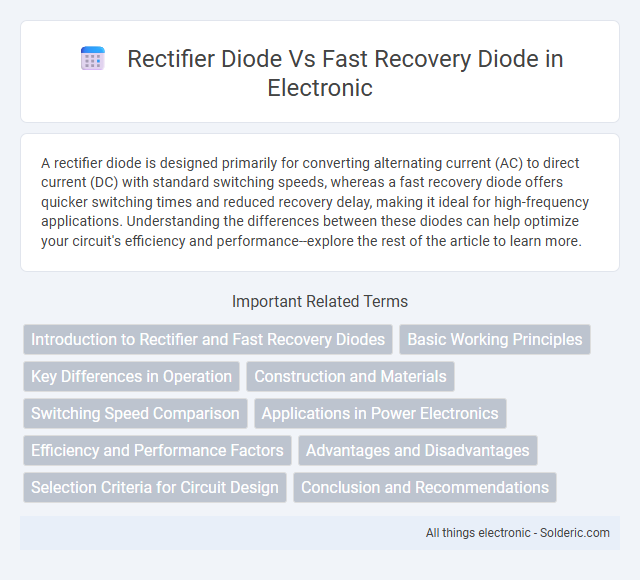A rectifier diode is designed primarily for converting alternating current (AC) to direct current (DC) with standard switching speeds, whereas a fast recovery diode offers quicker switching times and reduced recovery delay, making it ideal for high-frequency applications. Understanding the differences between these diodes can help optimize your circuit's efficiency and performance--explore the rest of the article to learn more.
Comparison Table
| Characteristic | Rectifier Diode | Fast Recovery Diode |
|---|---|---|
| Purpose | Converts AC to DC in power supplies | High-speed switching in power electronics |
| Recovery Time | Long (typically > 2 ms) | Short (typically < 1 ms) |
| Switching Speed | Slow | Fast |
| Typical Applications | Power rectification, battery chargers, adapters | Inverters, motor drives, SMPS, RF circuits |
| Reverse Recovery Charge (Qrr) | High | Low |
| Forward Voltage Drop | Higher (~0.7 V) | Lower (~0.5-0.7 V) |
| Cost | Lower | Higher |
Introduction to Rectifier and Fast Recovery Diodes
Rectifier diodes are designed primarily for converting alternating current (AC) to direct current (DC) in power supply circuits, featuring longer reverse recovery times. Fast recovery diodes improve switching performance with significantly reduced reverse recovery times, making them suitable for high-frequency applications like switching power supplies and inverters. Understanding the electrical characteristics such as recovery time, forward voltage drop, and peak inverse voltage is essential in selecting the appropriate diode for efficient power conversion.
Basic Working Principles
A rectifier diode allows current to flow in one direction, converting AC to DC by blocking reverse voltage, making it ideal for standard power rectification. Fast recovery diodes also permit unidirectional current but are designed with a quicker switching speed to reduce recovery time and minimize energy loss in high-frequency applications. Your choice depends on whether slow or fast switching characteristics better suit your circuit's performance needs.
Key Differences in Operation
Rectifier diodes primarily conduct current in one direction with standard recovery time suitable for low-frequency applications, while fast recovery diodes feature significantly reduced reverse recovery time, enhancing performance in high-speed switching circuits. The reduced reverse recovery time in fast recovery diodes minimizes switching losses and electromagnetic interference, making them ideal for applications like switch-mode power supplies and inverters. Conversely, rectifier diodes are preferred in power rectification scenarios where switching speed is less critical.
Construction and Materials
Rectifier diodes are typically constructed using standard silicon semiconductor materials with a simple PN junction designed for handling high current at low switching speeds. Fast recovery diodes utilize specialized semiconductor materials and optimized PN junctions with thinner depletion regions to enable rapid switching and reduced reverse recovery time. The construction of fast recovery diodes often incorporates advanced doping profiles and epitaxial layers to enhance performance in high-frequency applications.
Switching Speed Comparison
Fast recovery diodes offer significantly faster switching speeds compared to rectifier diodes, which helps reduce switching losses and improves efficiency in high-frequency applications. The reverse recovery time of fast recovery diodes is typically in the nanosecond to microsecond range, while rectifier diodes exhibit slower recovery times, often in the microsecond range or longer. Understanding these differences enables you to select the optimal diode type for circuits requiring rapid switching performance and minimal energy loss.
Applications in Power Electronics
Rectifier diodes are primarily used in power electronics for converting alternating current (AC) to direct current (DC) in applications such as power supplies, battery chargers, and motor drives, where efficiency and reliability are crucial. Fast recovery diodes excel in high-frequency switching circuits like switching power supplies, inverters, and pulse circuits due to their rapid recovery time, which minimizes switching losses and electromagnetic interference. Selecting between rectifier diodes and fast recovery diodes depends on the switching speed requirements and the need to handle high surge currents in power electronic designs.
Efficiency and Performance Factors
Fast recovery diodes offer superior efficiency and performance compared to rectifier diodes due to their reduced reverse recovery time, which minimizes switching losses in high-frequency applications. These diodes enhance your circuit's overall speed and reduce heat generation, improving reliability and energy savings. Rectifier diodes, while robust and cost-effective, are less efficient under fast switching conditions, limiting their effectiveness in modern power electronics.
Advantages and Disadvantages
Rectifier diodes offer high voltage and current handling capabilities with low cost and simple design but have slower switching speeds, leading to higher switching losses. Fast recovery diodes provide quicker recovery times, reducing switching losses and electromagnetic interference, making them ideal for high-frequency applications; however, they tend to be more expensive and have lower peak surge current ratings compared to rectifier diodes. Choosing between the two depends on balancing cost, efficiency, and application frequency requirements.
Selection Criteria for Circuit Design
Rectifier diodes are ideal for standard power conversion tasks due to their ability to handle higher current and voltage ratings with low reverse recovery time, making them suitable for circuits with moderate switching frequencies. Fast recovery diodes are optimized for high-speed switching applications, exhibiting significantly reduced reverse recovery time and lower switching losses, which enhances efficiency in high-frequency circuits such as switching power supplies and inverters. Your selection should prioritize the diode's recovery time, voltage rating, and switching frequency to ensure optimal performance and reliability in your specific circuit design.
Conclusion and Recommendations
Fast recovery diodes offer significantly reduced reverse recovery time compared to rectifier diodes, making them ideal for high-frequency switching applications and improving overall circuit efficiency. For power applications requiring low switching losses and enhanced performance, fast recovery diodes are recommended, while standard rectifier diodes remain suitable for low-frequency, high-current rectification tasks. Selecting the appropriate diode should consider switching speed requirements, reverse recovery characteristics, and thermal management to optimize reliability and energy efficiency.
Rectifier diode vs Fast recovery diode Infographic

 solderic.com
solderic.com